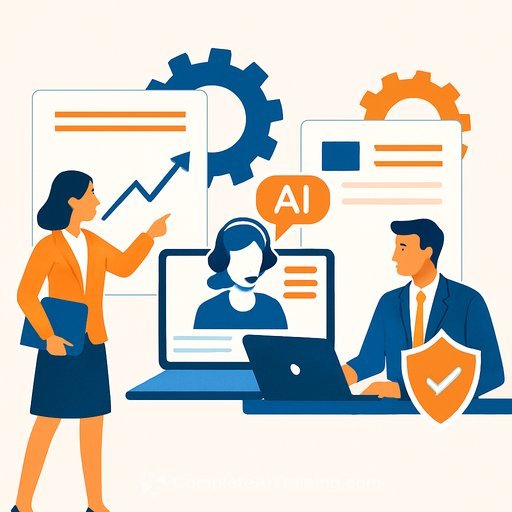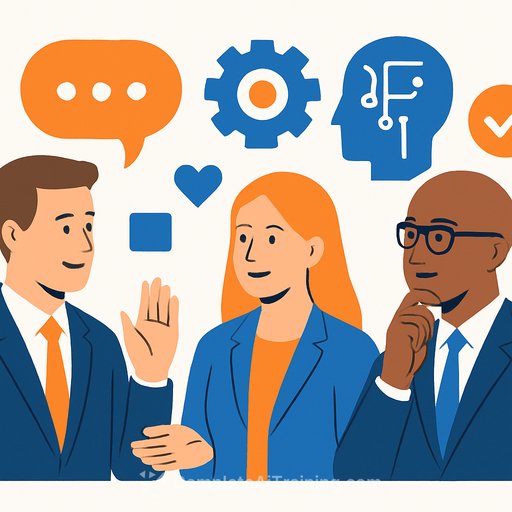AI is quietly reshaping the office. HR is in the driver's seat.
As return-to-office picks up, the "office" is no longer just desks and meeting rooms. It's a system. Sensors, software agents, and even robots are starting to influence how buildings run and how people get work done.
At Salesforce, this shift is already live. Their real estate and workplace leader, Relina Bulchandani, oversees 100+ offices worldwide and treats space like a product: measure, iterate, and improve. The goal is simple-give people the right space at the right moment so they can actually do their best work.
What Salesforce is doing (and what HR should notice)
- From badge swipes to dwell time. Sensors and analytics don't just count who came in. They show how long people stay, which rooms they use, and what gets ignored. If a room has high foot traffic but low stay time, they tweak furniture, layout, or features to boost actual use.
- Agents for facilities work. An internal "Workplace Agent" auto-prioritizes maintenance requests and builds shift-based to-do lists. Less manual triage, faster fixes, and more time for higher-value tasks.
- Robotics on patrol. Roaming machines spot issues like an open door or overflowing trash and file work orders on the spot. It's boring work done consistently-so people can focus elsewhere.
- Employee help, on demand. A chat-based "Employee Agent" in Slack fetches common HR docs within seconds. No extra logins. Fewer tickets piled on HR.
- Dynamic seating, not static charts. Agents help match people to spaces based on team, purpose, and even travel budgets. The office changes shape based on demand.
- Principle: fewer tools, higher adoption. The focus is on what people will use and what actually works-quality over quantity. That's how you scale without chaos.
Why this matters for HR
Workplace experience is now a product HR co-owns with Real Estate, IT, and Facilities. That means new inputs (sensor data), new levers (agents and automation), and new responsibilities (policy, trust, and change management).
If you want a healthier in-office culture, make the office feel useful. AI can help you see what's working and fix what's not-fast.
A 90-day HR playbook
- Weeks 1-2: Define outcomes. Pick three problems to solve: meeting room no-shows, slow maintenance turnaround, confusion finding HR resources, or low utilization of focus spaces.
- Weeks 2-4: Baseline and privacy guardrails. Establish metrics (utilization, dwell time, ticket resolution, satisfaction). Draft a clear policy for data collection, consent, retention, and opt-outs. Align with IT, Legal, and Facilities. Reference the NIST AI Risk Management Framework.
- Weeks 4-8: Pilot one agent. Options: a facilities triage agent, a Slack-based HR doc assistant, or a dynamic room-booking pilot for two floors. Keep scope tight and visible.
- Weeks 8-10: Tune the experience. Use feedback and utilization data to adjust layouts, policies, and prompts. Train managers to encourage use without micromanaging presence.
- Weeks 10-12: Prove value and expand. Share the before/after: time-to-fix, employee effort saved, utilization lift, fewer HR tickets. Plan the next agent or feature only if adoption is strong.
Guardrails HR should own
- Transparency: Tell people what's tracked (e.g., room usage), why, and how long data is kept. No secret monitoring.
- Consent and minimalism: Collect the least data needed to solve the problem. Aggregate wherever possible.
- Fairness: Don't let seat or space recommendations quietly disadvantage certain teams or travel budgets without review.
- Change support: Teach people how to use agents. Reward usage, not presence.
Metrics that actually matter
- Space: Utilization by zone, dwell time, meeting room success rate, focus-space availability.
- Operations: Work order time-to-close, first-time fix rate, after-hours issues detected by robots/agents.
- People: HR ticket deflection via chat agents, time-to-information for policies and documents, employee satisfaction by space type.
- Cost: Cost per seat, travel/space alignment, maintenance hours spent on low-value tasks.
Start small, prove it, then scale
One well-adopted agent beats ten shelfware tools. Pick the narrowest, most visible problem, and make it painless for employees. Let the data show where to go next.
The future office is a partnership: humans, agents, and robots-each doing what they do best. HR's role is to make that partnership trustworthy, useful, and simple.
Upskill your team
If your HR org is building AI literacy and practical skills, explore curated learning paths by role here: Complete AI Training: Courses by Job.
Your membership also unlocks:






